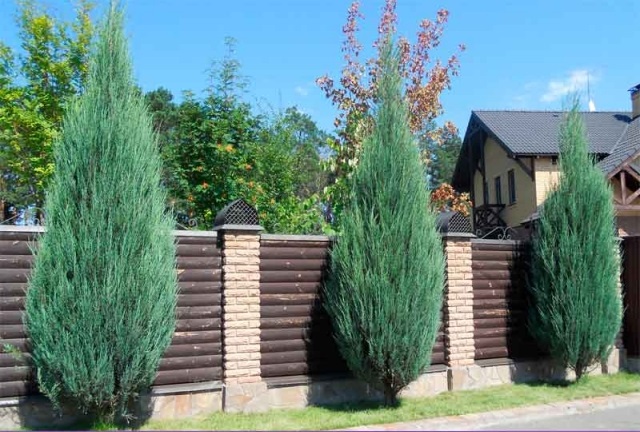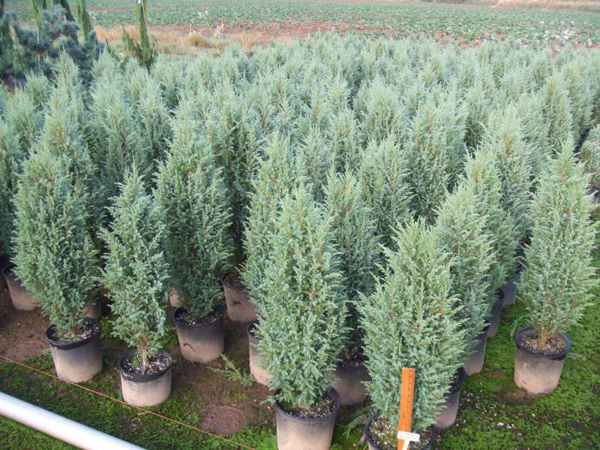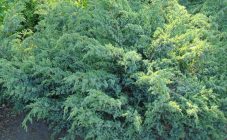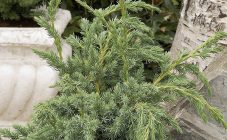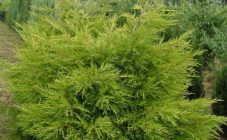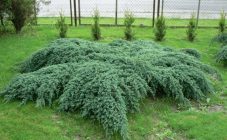Content:
The rocky juniper Skyrocket is used in landscaping as a vertical. The name speaks for itself: in translation from English skyrocket - "rushing upward." This juniper is a living decoration of local areas, parks and gardens.
Characteristics of culture
Juniper is a member of the Cypress family. It belongs to the coniferous species of evergreen trees. They can grow in the form of columnar or spreading trees, creeping or erect shrubs. The needles on their branches can be in the form of needles or scales. The growth rate of trees is average.
They produce fruits, the use of which is extensive: they are added to fruit drinks, compotes, marinades, pickles. When added to meat, the dish will be enriched with a piquant taste and aroma.
Description of Skyrocket Juniper
Skyrocket was bred by breeders in the 19th century. For 20 years, it is able to reach a height of 8 m with a trunk diameter of 20 cm. Every year, a juniper grows 15-18 cm in height, up to 5 cm in width.
The related plants from which Skyrocket is grown are native to the mountain slopes of North America. That is why this variety is unpretentious to the composition of the soil and winter-hardy. The root system goes deep into the ground, so it holds firmly. Even a strong wind cannot bring down Skyrocket.
This variety is characterized by a columnar shape, the growth of branches from the very base, a bluish-gray color of the needles. Dense shoots adhere tightly to the trunk. Juniper Skyrocket is used as a vertical element in garden plots and other landscaped areas.
Landing
The younger the planted plant, the easier it will take root. Also, adaptation will be better if the green space is planted with a clod of earth.
Juniper planting process step by step:
- A hole is dug up to 0.6 m deep, on the bottom of which small stones, broken shards or expanded clay are laid. The width of the pit should be 2 times the size of the pot in which the juniper grew.
- A young seedling is removed from the container, without breaking an earthen clod, it is planted in a prepared hole.
- The root system is covered with a substrate made up of turf, peat, sand (1: 1: 1).
- The soil is rammed, watered abundantly.
- If necessary, a substrate is also added, then the trunk circle is mulched with peat, wood chips.
After all the procedures performed, the root collar should be flush with the soil surface.
Reproduction
To breed many plants at home, the cuttings method is used. The seed method is ineffective, since the planting material takes a long time to germinate and may not transfer maternal qualities. It is difficult to propagate Skyrocket by layers, because its branches rush upward and it is difficult to pin them to the ground.
The propagation process by cuttings in more detail:
- The shoot breaks off from the top of the plant with a small piece of bark (with a heel). The length of the handle is 12-20 cm.
- Then it is half-cleared of the needles, the lower part of the cutting is immersed in the growth enhancer powder (for example, root).
- The prepared shoot is planted in a box with a soil mixture of peat, sand and turf to a depth of 2 cm.If there are several shoots, a distance of 6-7 cm is maintained between them.
- The substrate with cuttings is watered with water.
- The box creates a greenhouse effect. To do this, he is covered with glass or film. The greenhouse is ventilated every day.
The plant is considered fully rooted after 3 months. After that, young plants are planted in separate grow pots. Juniper can be cut all season, but the best survival rate and growth occurs in spring.
Further care
The first time after planting, the Skyrocket juniper is well watered. An adult plant needs watering no more than 2-3 times per season. Juniper has a deep root system and, unlike other plants, it has enough moisture from groundwater. But spraying the crown with water by sprinkling will be perceived by the plant favorably.
The peculiarity of caring for this variety is that it needs to be tied with twine for the winter. This will prevent the trunk from cracking and breaking branches from the pressure of the snow.
At the end of winter, there is a high probability of burning the needles by the sun's rays. Therefore, the plant should be shaded with a covering material. Also at this time, you need to carry out one more procedure: remove the snow and water the plant with water. This will help warm the soil more quickly and prevent the needles from drying out.
Every spring before the start of sap flow, sanitary pruning is performed. In this case, broken and diseased branches are cut out. Pruning can be done to form a topiary plant. The instrument for these procedures must be well disinfected.
Frequent feeding of the juniper is not required. It is enough to spill it with a fertilizer solution for conifers in April. Before and after feeding, the trunk circle is spilled with water.
Diseases and pests
Juniper can be attacked by miner moths, aphids, scale insects, spider mites. At the first detection of them, the juniper must be sprayed with a solution of any insecticide. To prevent their invasion, the plant is treated every spring with the same drugs.
A common juniper disease is rust. With this fungal disease, the branches are covered with yellow mucus. As a treatment in the initial stages of the disease, a solution of Bordeaux liquid or other copper-containing preparations is used.
If it is not possible to get rid of the fungal infection, the plant is dug up and burned. The planting site is treated with a fungicide.
Application in landscape
Rock juniper Skyrocket is widely used in landscape gardening. It is used to create alleys, used in garden compositions. Planted as a hedge, the plants will cover the summer cottage from prying eyes. They can also serve as a protective strip of various green spaces from winds and dust.
This variety of juniper can grow singly, since it is self-sufficient in design and does not need any environment. But if there is a goal to make a composition out of it, this will also be a beautiful option. Juniper is combined with other conifers, as well as deciduous plants. To add color to the garden, tall plants with bright flowers are planted next to it. Low-growing crops are located between them: clover, thyme, subulate bryozoan.
In addition to the beauty of the plant, gardeners value juniper needles for their healing properties. Planting a tree in gardens, parks and squares will create a pleasant and calm atmosphere there, and the phytoncides released by the tree will improve the surrounding air.
It is so easy and simple to refine your summer cottage with Skyrocket juniper. It is easy to care for, has many benefits and takes a long time to grow!
